Book contents
- Frontmatter
- Contents
- List of Contributors
- Detailed Contents
- Acknowledgements
- Abbreviation List
- 1 Endothelium
- 2 Vascular smooth muscle structure and function
- 3 Atherosclerosis
- 4 Mechanisms of plaque rupture
- 5 Current and emerging therapies in atheroprotection
- 6 Molecular approaches to revascularisation in peripheral vascular disease
- 7 Biology of restenosis and targets for intervention
- 8 Vascular arterial haemodynamics
- 9 Physiological Haemostasis
- 10 Hypercoagulable States
- 11 Platelets in the pathogenesis of vascular disease and their role as a therapeutic target
- 12 Pathogenesis of aortic aneurysms
- 13 Pharmacological treatment of aneurysms
- 14 Pathophysiology of Aortic dissection and connective tissue disorders
- 15 Biomarkers in vascular disease
- 16 Pathophysiology and principles of management of vasculitis and Raynaud's phenomenon
- 17 SIRS, sepsis and multiorgan failure
- 18 Pathophysiology of reperfusion injury
- 19 Compartment syndromes
- 20 Pathophysiology of pain
- 21 Post-amputation pain
- 22 Treatment of neuropathic pain
- 23 Principles of wound healing
- 24 Pathophysiology and principles of varicose veins
- 25 Chronic venous insufficiency and leg ulceration: Principles and vascular biology
- 26 Pathophysiology and principles of management of the diabetic foot
- 27 Lymphoedema – Principles, genetics and pathophysiology
- 28 Graft materials past and future
- 29 Pathophysiology of vascular graft infections
- Index
9 - Physiological Haemostasis
Published online by Cambridge University Press: 05 June 2012
- Frontmatter
- Contents
- List of Contributors
- Detailed Contents
- Acknowledgements
- Abbreviation List
- 1 Endothelium
- 2 Vascular smooth muscle structure and function
- 3 Atherosclerosis
- 4 Mechanisms of plaque rupture
- 5 Current and emerging therapies in atheroprotection
- 6 Molecular approaches to revascularisation in peripheral vascular disease
- 7 Biology of restenosis and targets for intervention
- 8 Vascular arterial haemodynamics
- 9 Physiological Haemostasis
- 10 Hypercoagulable States
- 11 Platelets in the pathogenesis of vascular disease and their role as a therapeutic target
- 12 Pathogenesis of aortic aneurysms
- 13 Pharmacological treatment of aneurysms
- 14 Pathophysiology of Aortic dissection and connective tissue disorders
- 15 Biomarkers in vascular disease
- 16 Pathophysiology and principles of management of vasculitis and Raynaud's phenomenon
- 17 SIRS, sepsis and multiorgan failure
- 18 Pathophysiology of reperfusion injury
- 19 Compartment syndromes
- 20 Pathophysiology of pain
- 21 Post-amputation pain
- 22 Treatment of neuropathic pain
- 23 Principles of wound healing
- 24 Pathophysiology and principles of varicose veins
- 25 Chronic venous insufficiency and leg ulceration: Principles and vascular biology
- 26 Pathophysiology and principles of management of the diabetic foot
- 27 Lymphoedema – Principles, genetics and pathophysiology
- 28 Graft materials past and future
- 29 Pathophysiology of vascular graft infections
- Index
Summary
INTRODUCTION
Physiological haemostasis involves complex interactions between endothelial cells, platelets and coagulation proteins, that result in a prompt platelet plug and then localised thrombus formation at the site of a break in vascular integrity. Numerous regulatory processes prevent widespread activation of coagulation, ensuring that blood remains fluid in the absence of vascular injury or other pathology. All components of the haemostatic process can be disturbed resulting in either a pro-thrombotic or bleeding tendency, and drugs that modify the haemostatic process are commonly used, particularly in patients with vascular disease. An understanding of normal haemostasis is therefore important for all clinicians that deal with this patient group.
PRIMARY HAEMOSTASIS
Primary haemostasis is the initial response of the body to vascular injury, and involves interaction between platelets, adhesive proteins located in the subendothelial matrix (including collagen and von Willebrand factor), and circulating fibrinogen. The end result of primary haemostasis is the formation of a stable platelet plug around which a fibrin network can then be built. This same process is responsible for the pathogenic thrombus formation in patients with arterial disease. Disorders of primary haemostasis tend to manifest in the main as mucosal bleeding, including epistaxis, oral bleeding and menorrhagia, and often immediate difficulty with haemostasis in the post-operative setting.
Platelets
Platelets are small fragments of megakaryocyte cytoplasm that in the resting state are small discoid structures. The normal range for circulating platelet count in adults is between 150 to 400 × 109/L.
- Type
- Chapter
- Information
- Mechanisms of Vascular DiseaseA Reference Book for Vascular Specialists, pp. 177 - 188Publisher: The University of Adelaide PressPrint publication year: 2011
- 1
- Cited by

